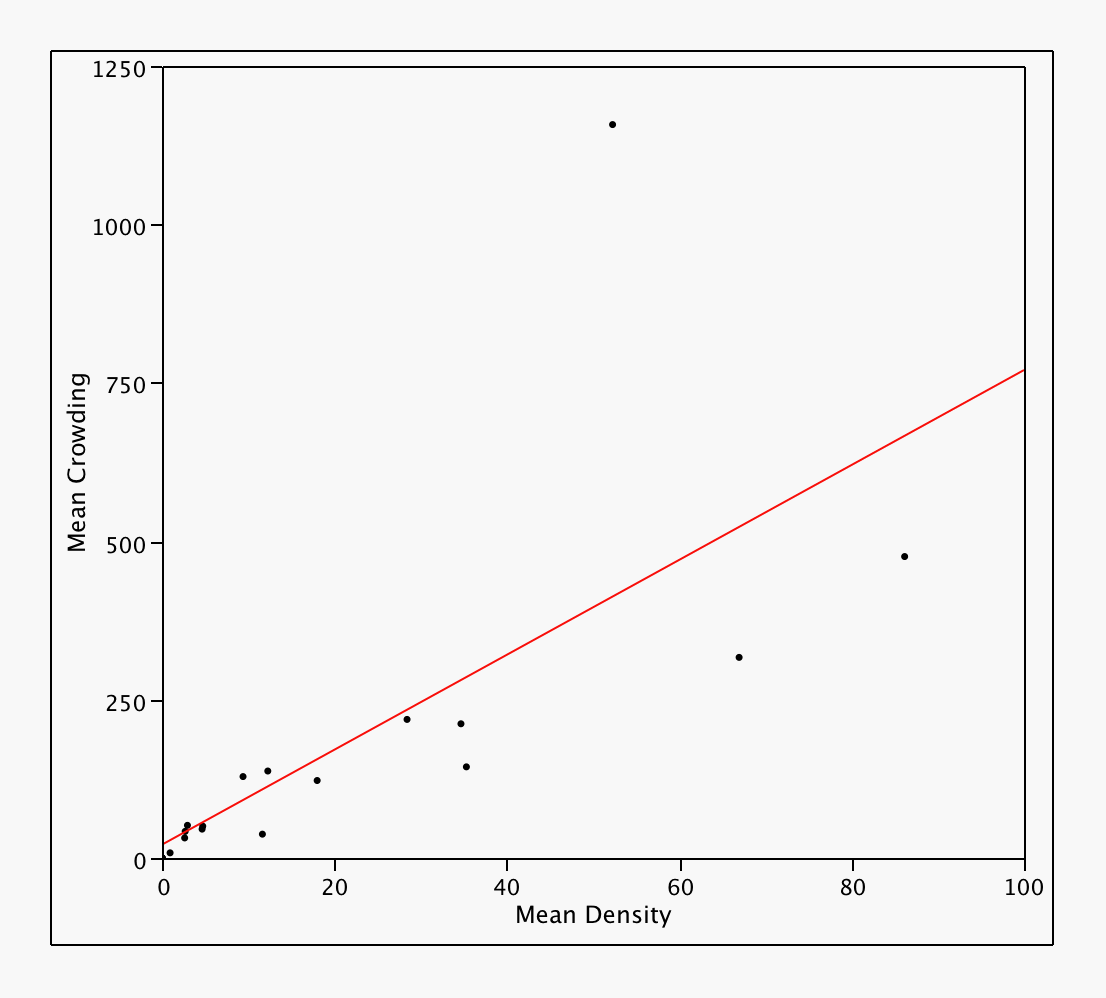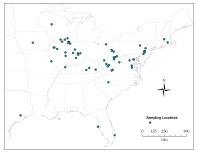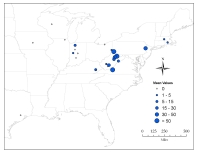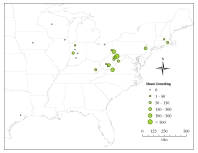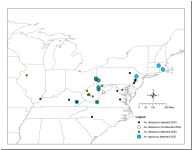| Results of the
2006 Labor Day Mosquito Count Many thanks for participating in the 2006 Labor Day Mosquito Count! We appreciate your patience as we report back to you, and thank you for all your efforts of last fall. We hope you'll be able to participate again next year, as it is important for us to have repeated samples from the same areas over several years. We also hope to improve the content we're providing each year. With this summary, we provide:
If any of you have any questions or requests, please let us know by email We are hoping to expand our sampling network considerably for the coming fall. If you have colleagues who might be interested, please let them know about this project and encourage them to contact me. Thanks again! We'll be in touch as the next mosquito count approaches, and we wish you a pleasant summer until then. Best regards, Todd Livdahl |
| Highlights for 2006 We seem to be learning different things each year. The 2004 Mosquito Count revealed the Asian Tiger mosquito Aedes albopictus to be in several places where it had not been seen before. This year, we have a similar set of discoveries for another Asian introduced species, Ochlerotatus japonicus. This mosquito was first found in New Jersey in 1998, and shortly thereafter was found in the New York City area and Connecticut. It has become common in Southern New England; our findings indicate that this species has spread westward, as well as northward. The invasion of northern states by Ochlerotatus japonicus and the invasion of southern states by Aedes albopictus raises interesting questions about what will happen when these species begin to overlap, and what will be the consequences to native mosquitoes. We have yet to complete our species identifications from 2006, but so far, we have still found O. japonicus, Ae. albopictus and the native O. triseriatus in only one place (Hazard, KY). Other findings:
Our research plan calls for analysis of change in abundance, so it is especially valuable to have repeated participation. We thank the following groups for
participating in their fourth Labor
Day Mosquito Count, and for tolerating all of our mistakes of
inexperience during each of those years:
Blacksburg VA (Mike Rosenzweig and SEEDS) Hazard KY (Barbara Weaver) Loyal WI (Barb Kingsbury) Dahinda IL (Sharon Farquer) Junction IL (Mark York) The following groups have completed their third year of collaboration, and we're glad we still have you: Oxford NJ (Christine Musa) Houston PA (Gary Popiolkowski) New Cumberland WV (Jules Adam, Stephan Smolski) Riverside/East Providence RI (Mary McCarthy) Buckhannon WV (Michele Benson) Beckley WV (Susan Westfall) Belle WV (Rachelle Marion) Bridgeport WV (Robin Anglin) Fayetteville WV (Wayne Yonkelowitz) The following groups have now participated for two years: Carmel IN (Laurie Yesh) Pendleton IN (Laura Miller) Crawfordsville IN (Amy Gillan) Oxford NJ (Christine Musa) Beachwood OH (Joe Burwell) Paxton MA (Christy Barnes, Ted Purcell, Scott Wahlstrom) We were happy to have the following groups participate for the first time, and we hope to have you back next year: Vega TX (Jennifer Stroup) Houston TX (Kay Rhea) Delphi IN (Kirk Janowiak) Crystal Lake IL (Annette Rafferty) Bloomington IN (Donna Bernens-Kinkead and Laura Hershberger) Beachwood OH (Joe Burwell) Ankeny IA (Kathy Megivern) Return to contents |
| Background on measures of abundance Various approaches can be used to summarize the abundance of mosquitoes in an area. The number of mosquito eggs laid within a trap of the sort we use in this study is an example of the use of a relative measure of abundance. We obtain a number that is useful in comparing different areas or habitats, or for tracking changes through time, but it does not tell us the number of mosquitoes per unit area or volume of habitat, because we don't know how many mosquitoes within the habitat were actually drawn to the trap, and how many were not. Nonetheless, we can still talk about density of eggs within the traps themselves, so using the trap as our habitat, the mean density, or average number of eggs per trap gives us a way to describe each site relative to the others. The choices made by our students could have a strong influence on mean density. Mosquitoes use environmental cues to make decisions about how permanent a container of water is likely to be, as well as whether it's likely to have enough food to support her offspring through their development. A trap in the middle of the parking lot of an apartment complex is not going to attract as many female mosquitoes looking for good habitats for their offspring as a trap set in a damp, dark forest. So, locations of traps can affect mean density. A way to avoid this possible problem is to let the mosquitoes determine which habitats are suitable, and to try to measure the degree of crowding that the mosquitoes experience. If we count, for each individual, the number of neighbors they share their habitat with, and average this for all the individuals, then our measure is not affected by traps that are laid in places that mosquitoes cannot reach or that they find unacceptable. This measure of Mean Crowding may actually provide a better description of the conditions experienced by the typical developing mosquito larva, and it is at the larval stage that mosquitoes are most likely to experience competition for food. We provide sample calculations for mean density and mean crowding here |
Raw Data We will be distributing raw data files to all participating group leaders in the form of Excel files attached to e-mail messages. For the present, If you wish to see the data, you will need to join our sampling network. At some later time we plan to make all data completely accessible. Return to contents |
Maps of sampling sites, and graphic results summaries for 2006
Return to contents |
||||||||
| Practical difficulties, and potential
solutions We have settled on a standard method, although consistency in site selection by participating students remains a challenge beyond our control. The new design has its problems, especially drying and tipping of the traps, but we must live with them in order to have data that can be compared from year to year with some validity. When traps dry out, they blow around, and mosquitoes don't recognized them as good places to lay eggs. Dry traps are uninformative or misleading about how many mosquitoes there are. This can be avoided by having students add water every three days. Some means of protection against tipping will also be useful in our next trial, and we have received some good suggestions that we'll include in our instructions for next year. Some groups did not collect any eggs in their traps. This is not necessarily a problem, because it is possible that mosquitoes were not present during the sampling period. In some places, it might even be expected. We might also expect an absence of mosquitoes during dry spells, or after an insecticide spraying program. Processing trap liners remains a difficult task, particularly when the liners have been shipped in too wet a state, so that they are soggy on arrival. This forces us to spend hours teasing apart wet paper overgrown with fungi, not a pleasant task, and we don't have a lot of confidence in the egg counts we obtain from such liners. We were completely unable to process samples from one group, as the liners were so disintegrated that we did not have confidence in our egg counts. Our number of participants needs to increase, and we must make this a priority effort for this summer. If you can help us to spread the word about this project, we'd appreciate it. Return to contents |
| Overview, and plans for next year In the first three years of this study, we have expanded knowledge about where two introduced species are living, and this kind of information about past success is useful for predicting where they might succeed or fail in the future. Our broader goal is to see what the effect of the invading species are on the native mosquito, Ochlerotatus triseriatus. The project began with a focus on just the Asian species, Aedes albopictus, but we will be expanding our goals to include the influence of Ochlerotatus japonicus, which arrived in the Northeast in the late 1990s. We saw this species for the first time last fall in our study site in Worcester, MA, and by taking a close look at one place we might be able to detect its effect on the native species, which we have been studying for quite a while prior to the arrival of the invader. Next fall, there will be a course on Ecology of Disease Vectors. One of the aims of this course will be to help in the processing of these samples, and also to improve the educational content of this site. We'll be experimenting with a number of approaches using a variety of media. Suggestions are welcome. Thanks again for all your help, and please let us know what we can do to improve this experience for your kids. Return to contents |
